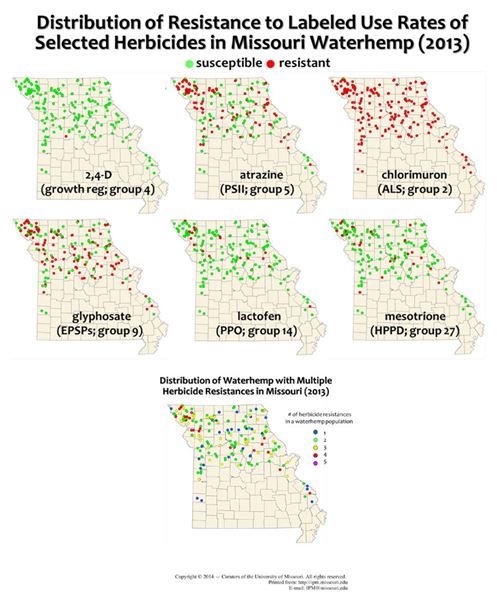The Situation With Herbicide Resistance In Missouri Waterhemp
JOHN SCHULTZ
COLUMBIA, MO.
In 2012, 187 waterhemp seed samples were collected from soybean
fields across the state of Missouri to determine the distribution and
extent of herbicide resistance to six different herbicide modes of
action. We screened each of these populations to labeled use rates (1X
rates) of these herbicides once plants reached 4-inches in height.
Results indicate that practically all waterhemp populations are
resistant to group 2 (ALS-inhibiting) herbicides like chlorimuron
(Classic). Atrazine (group 5) and glyphosate (group 9) resistance was
present in 51 and 58 percent of the populations tested, respectively.
Resistance to group 14 (PPO-inhibiting) herbicides like lactofen (Cobra)
was observed in 11 percent of the populations while resistance to group
27 (HPPD-inhibiting) herbicides like mesotrione (Callisto) was present
in 14 percent of the populations. Perhaps even more concerning is the
fact that 84 percent of the populations tested were resistant to at
least 2 different herbicide modes of action, 39 percent were 3-way
resistant, 11 percent were 4-way resistant, and one population was
resistant to 5 different herbicide modes of action.

As you plan your soybean weed management program for the season, it
is important to consider these results and understand the extent of
multiple herbicide resistances in waterhemp in Missouri. In order to
manage and mitigate herbicide-resistant waterhemp in your fields, you
must integrate all available cultural and chemical control tactics
available with the ultimate goal of eliminating waterhemp from your
fields and preventing seed production altogether. This means
incorporating cultural control practices like narrow row spacings and
optimum soybean plant populations along with a herbicide program that
contains multiple herbicide modes of action that are effective on
waterhemp. As a result of the multiple resistances present in Missouri
waterhemp, some of the most effective herbicide options left for
waterhemp are pre-emergence, residual applications of the group 14
(PPO-inhibiting) and group 15 (long-chain fatty acid inhibiting)
herbicides and/or “overlapping” or “layered” applications of these
herbicides. But we will save a discussion of the overlapping residual
herbicide program for a future article. For a more complete explanation
of herbicide classification and list of herbicides belonging to these
groups, see here: http://weedscience.missouri.edu/publications/47575_FINAL_TakeAction_HerbicideClassChart.pdf.∆
JOHN SCHULTZ: M.S. Student, Division of Plant Sciences, University of Missouri
DR. KEVIN BRADLEY: Associate Professor, Division of Plant Sciences, University of Missouri